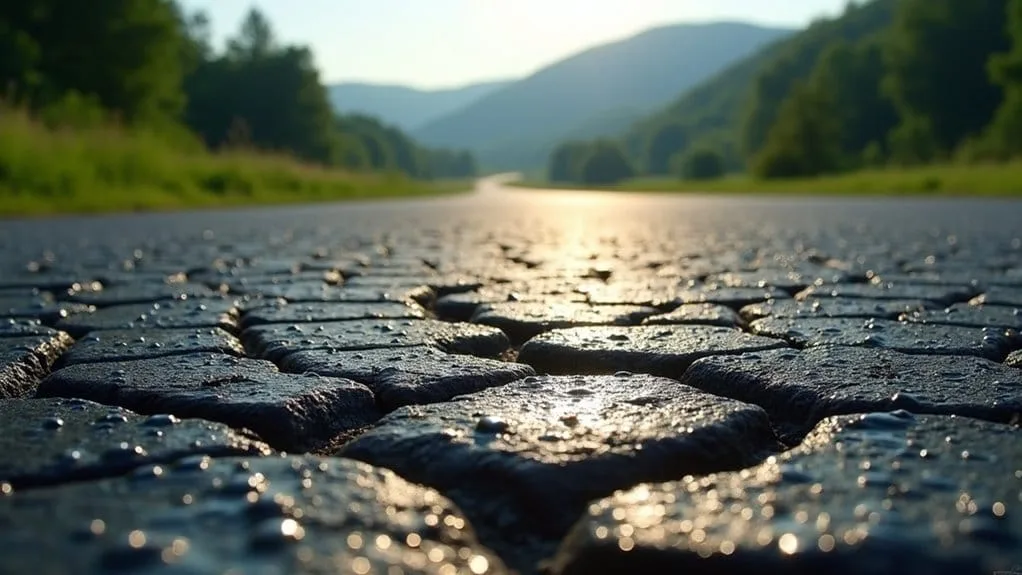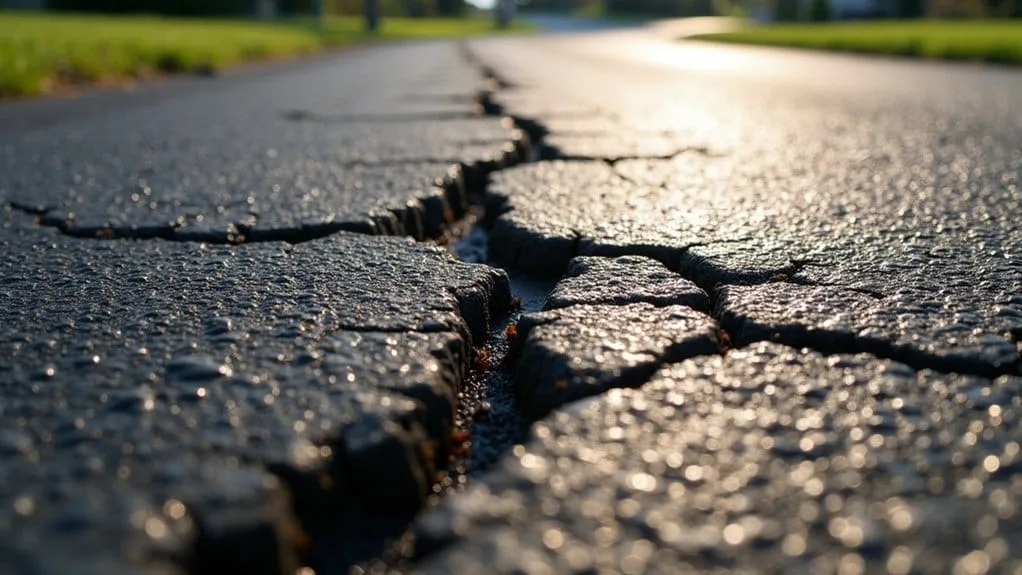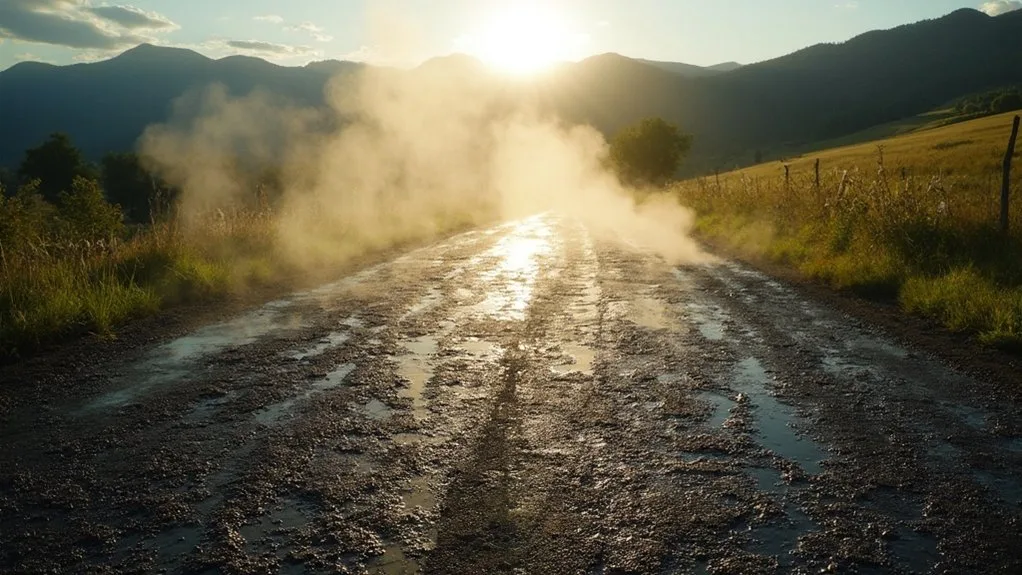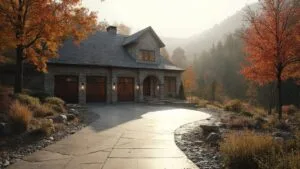Central Pennsylvania’s summer combo of heat and humidity can wreak havoc on your asphalt. When temperatures soar past 85°F, your pavement expands and develops heat bumps. The high humidity makes things worse! Moisture seeps into tiny cracks and weakens the binding materials. You’ll notice spider-web cracking, soft spots, and surface peeling. Regular sealcoating every 2-3 years creates a protective barrier. Let’s investigate exactly how to shield your asphalt from this damaging duo.
Key Takeaways
- Central Pennsylvania’s summer heat and high humidity create a damaging cycle of moisture seepage and thermal expansion in asphalt surfaces.
- High temperatures reaching 90°F cause asphalt to expand, leading to surface buckling and heat bumps in pavement.
- Humidity trapped within pavement cracks weakens binding materials and creates pressure pockets that cause structural damage.
- The region’s wet-dry cycles accelerate asphalt deterioration by breaking down essential oils and creating spiderweb crack patterns.
- Regular sealcoating every 2-3 years protects asphalt from Central Pennsylvania’s harsh combination of heat and humidity.
Understanding Central Pennsylvania’s Summer Climate

Three distinct seasons define Central Pennsylvania’s summer climate: hot, hotter, and humidity!
You’ll experience significant seasonal variations from June through September. Early summer brings warm days with moderate humidity levels.
By July, you’re dealing with temperatures regularly hitting 85-90°F! August becomes a real challenge – that’s when the most impactful weather conditions occur.
Key Impact Factors:
- Morning temps start at 70°F
- Afternoon highs reach 90-95°F
- Humidity levels often exceed 80%
- Heat index can feel like 100°F+
Your summer calendar in Central PA looks like this:
June: Warming Up Phase
July: Peak Heat Season
August: Heat + Humidity Combo
September: Gradual Relief
The combination of these factors creates unique challenges for asphalt surfaces. Additionally, high-quality materials used in asphalt paving can help mitigate some of the damage caused by extreme weather.
You’ll notice the biggest changes during those sweltering August afternoons!
Common Heat-Related Asphalt Damage
When summer temperatures soar, asphalt surfaces take a serious beating!
You’ll notice several types of damage appearing on your pavement during intense heat waves. Asphalt expansion causes the surface to buckle and form raised areas – these are called heat bumps! The pressure builds until something has to give.
Thermal cracking shows up as spiderweb patterns across your parking lot or driveway. These cracks start small but grow fast. The constant heating and cooling cycles stress your asphalt beyond its limits.
Watch out for these other heat-related problems:
- Soft spots that leave tire marks
- Surface raveling where stones come loose
- Oil spots that bubble up through the pavement
- Edge crumbling near grass or concrete borders
Don’t ignore these warning signs! They’ll only get worse if left untreated. Regular asphalt maintenance services can help preserve your pavement and extend its lifespan.
The Role of Humidity in Asphalt Deterioration

Humidity deals your asphalt a double punch when combined with intense heat!
Your asphalt composition faces serious challenges when moisture retention meets scorching temperatures. The combination creates a perfect storm that can wreak havoc on your pavement investment.
Here’s how humidity attacks your asphalt:
- Water seeps into tiny surface cracks and expands when temperatures rise – BOOM, bigger cracks appear!
- High moisture levels soften the binding materials that hold your asphalt together – it’s like destroying the glue!
- Trapped moisture beneath the surface creates pressure pockets that push upward – causing nasty bulges!
- The constant wet-dry cycle from humidity breaks down essential oils in your asphalt – weakening its structure!
Don’t let humidity be your pavement’s enemy! Understanding these effects helps you protect your investment better. Regular seal coating your driveway can significantly extend the lifespan of your asphalt surfaces.
Preventive Measures for Summer Asphalt Protection
Protecting your asphalt investment during summer requires smart preventive action!
You’ll want to start with professional asphalt sealcoating benefits. A fresh sealcoat creates a protective barrier against harsh UV rays and summer storms. Schedule this service every 2-3 years for ideal protection. Regular sealcoating can extend asphalt life by 30-50% compared to unsealed surfaces.
Temperature fluctuations effects can wreak havoc on your pavement! Install proper drainage systems to prevent water pooling. Fill cracks immediately – even small ones can expand rapidly in summer heat.
Key Summer Protection Steps:
- Apply reflective coatings to reduce heat absorption
- Keep heavy vehicles off hot asphalt (especially after 2 PM)
- Remove oil spills promptly to prevent surface softening
- Schedule repairs for early morning hours
- Maintain clean gutters to prevent water damage
Don’t wait for damage to appear! Regular inspections and maintenance will keep your asphalt strong all summer long.
Signs of Heat and Humidity Stress on Pavement

Extreme summer conditions leave telltale warning signs on your asphalt pavement!
You’ll want to watch for these critical indicators that heat and humidity are damaging your investment. The sooner you spot these signs, the better chance you’ll have at preventing major repairs.
- Pavement cracking appears first as tiny hairline fractures that spread like spider webs.
- Surface peeling starts at the edges where your asphalt meets concrete or grass.
- Dark, oily spots emerge as the binding materials begin to separate and rise.
- Soft, squishy areas develop where the pavement can’t maintain its structure.
Don’t ignore these warning signs! They’re your pavement’s cry for help. Regular maintenance can extend driveway lifespan, so quick action now will save you thousands in repairs later. Your asphalt needs attention when temperatures soar and humidity levels climb.
Professional Maintenance Tips for Summer Weather
Now that you know the warning signs, let’s get practical with proven maintenance solutions!
Your best defense starts with professional asphalt sealing. Schedule this essential service during moderate temperature periods – typically early morning or evening hours. Don’t wait until extreme heat hits!
Quick Pro Tips:
- Monitor surface temperatures before maintenance work
- Keep traffic off newly sealed areas for 24-48 hours
- Address small cracks immediately to prevent spreading
- Install proper drainage systems to manage humidity
Temperature fluctuations can wreak havoc on your pavement. That’s why timing is everything! Plan your maintenance schedule around weather patterns. You’ll want to avoid both scorching afternoons and potential rain forecasts.
Remember: Prevention beats repairs every time. Regular inspections and prompt action will keep your asphalt strong through summer’s toughest conditions. Additionally, consider utilizing professional maintenance services to ensure the longevity and durability of your pavement.
Schedule professional evaluations twice yearly for best results.
Conclusion
Your asphalt’s health depends on how you handle Central PA’s brutal summer conditions. Just last year, the Harrisburg Mall had to repair $50,000 in damage when their untreated parking lot cracked during a 95-degree heatwave. Don’t let that be you! Take action now with regular inspections and maintenance. You’ll save money and protect your investment. Remember – prevention beats repairs every time.



